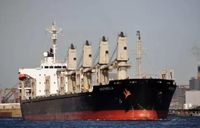The new Fosbucraa port project, located southwest of the city of Ayoun in Morocco, is making significant strides towards completion after six years of continuous construction. This ambitious project is part of a strategic vision aimed at enhancing the industrial and logistical infrastructure in the southern regions of Morocco, highlighting the country’s commitment to developing its economy and solidifying its position as a key player in the global phosphate market.
The Office Chérifien des Phosphates (OCP) oversees the Fosbucraa project, which seeks to expand its export capabilities and utilize natural resources more efficiently. Morocco, which possesses approximately 70% of the world’s phosphate reserves, aims to strengthen its role as a leading producer and exporter of phosphates and fertilizers. The project is designed to meet the growing global demand for fertilizers, especially in light of challenges related to global food security.
Key components of the Fosbucraa port include a 3.5-kilometer long bridge, which is 25 meters wide, allowing access to deep waters for accommodating large vessels. The port also features marine protection works extending 920 meters to ensure the safety of the facilities against waves and marine currents. Additionally, it includes a seawater intake facility capable of processing up to 30,000 cubic meters per hour, which is essential for the industrial complex's production processes.
Designed to receive Post-Panamax ships with a capacity of up to 100,000 tons, the Fosbucraa port enhances logistical efficiency and reduces transportation costs. This capability allows for the import of essential raw materials for fertilizer production, such as sulfur, and the export of final products like raw phosphates, fertilizers, and phosphoric acid.
The economic impact of the Fosbucraa port is expected to be significant for both the local and national economies. The project will create direct and indirect job opportunities and promote local development through improved infrastructure. Nationally, it is anticipated to increase Morocco's export revenues, reinforcing its position as a major supplier of phosphates and fertilizers in global markets, particularly in Africa, Asia, and Latin America.
Moreover, the OCP is committed to environmental sustainability in this project. The facilities are designed to minimize environmental impact on coastlines and marine ecosystems. The project emphasizes the use of modern technologies to improve energy efficiency and reduce emissions, aligning with Morocco’s broader goals of sustainable development.
As the completion of the Fosbucraa port approaches, it marks a strategic step towards bolstering the industrial and logistical sectors in Morocco. It embodies the kingdom’s vision of leveraging its natural resources to support sustainable development, with expectations that it will enhance the national economy and foster growth in the southern regions.
In a related development, the Safaga port in Egypt has also been active in phosphate exports. On April 14, 2025, the Red Sea Ports Authority reported the export of 32,000 tons of phosphates to India through the Safaga port. The authority noted that a total of 11 ships were present at its berths, handling 42,000 tons of general cargo.
The export activities included the handling of 622 passengers and 150 cars, with 4,000 tons of cargo entering the port. Additionally, the exit movement recorded 38,000 tons of cargo, along with 371 passengers and 125 cars. The Safaga port is scheduled to receive the ship NEW VICTORY while the ship BOS BROOK is set to depart with the phosphate shipment to India. Other ships, including the Poseidon Express and China, are also scheduled to leave the port.
On April 13, 2025, the port welcomed three vessels: Poseidon Express, China, and Amal, contributing to the ongoing trade activities. Furthermore, at the Nuweiba port, 2,100 tons of cargo were handled, along with 220 shipments, through marine movements involving the ships Ayla, Aour, and Al-Hussein. The authority's berths recorded the arrival and departure of 2,335 passengers across its ports, showcasing the bustling trade and transport operations in the region.
The developments at both the Fosbucraa port in Morocco and the Safaga port in Egypt highlight the strategic importance of phosphate production and export in the region. As countries like Morocco and Egypt work to enhance their logistical capabilities and meet global demands, they are positioning themselves as key players in the international phosphate market, which is vital for agricultural production worldwide.
Overall, the Fosbucraa port project stands as a testament to Morocco’s ambitions in the industrial sector, while the activities at Safaga port reflect the ongoing trade dynamics in the region. Together, these initiatives are set to shape the future of phosphate exports and contribute to economic growth in North Africa.


